SAND AND DESERT SOILS

Sand dunes in Xinjiang Most deserts are only around 20 percent sand. The remainder is mostly gravel and rock. Most of the sand is in sand sheets and sand seas--vast regions of undulating dunes resembling ocean waves "frozen" in an instant of time.
Nearly 50 percent of desert surfaces are plains where eolian deflation--removal of fine-grained material by the wind--has exposed loose gravels consisting predominantly of pebbles but with occasional cobbles. The remaining surfaces of arid lands are composed of exposed bedrock outcrops, desert soils, and fluvial deposits including alluvial fans, playas, desert lakes, and oases. Bedrock outcrops commonly occur as small mountains surrounded by extensive erosional plains. [Sources: “Deserts: Geology and Resources” by A.S. Walker, United States Geological Survey]
Soils that form in arid climates are predominantly mineral soils with low organic content. The repeated accumulation of water in some soils causes distinct salt layers to form. Calcium carbonate precipitated from solution may cement sand and gravel into hard layers called "calcrete" that form layers up to 50 meters thick.
Caliche is a reddish-brown to white layer found in many desert soils. Caliche commonly occurs as nodules or as coatings on mineral grains formed by the complicated interaction between water and carbon dioxide released by plant roots or by decaying organic material.
Websites and Resources on Deserts: United States Geological Survey usgs.gov/gip/deserts ; Desert USA (good info on the world’s deserts); desertusa.com/life ; United Nations Global Desert Outlook unep.org/geo/gdoutlook ; Desert Biome article, University of California, Berkeley Desert Biome ; Blue Planet Biomes (about U.S. deserts) blueplanetbiomes.org ; Wikipedia article Wikipedia ;National Geographic online article National Geographic Oxfam Cool Planet oxfam.org.uk/coolplanet ; Sand Dunes article waynesword.palomar.edu ; United States Geological Survey usgs.gov/gip/deserts
Sand
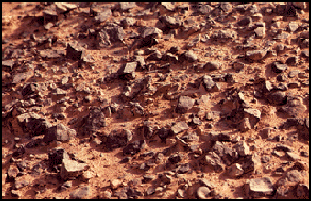
rocky sand Sand is nothing more than tiny rocks. In the United States it is defined as particles between .05 and 2 millimeters in diameter. Smaller particles are called silt or clay. Larger fragments are gravel. All sand was formed by breaking of rocks through the action of water, ice or air. The history of sand can be ascertained by examining it under a microscope: angular particles were created by glaciers; round grains have been weathered by wind or water
Sand (and sandpaper) is broken down into five categories: 1) very coarse (2 to 1 millimeters in diameter); 2) coarse (1 to .5 millimeters in diameter); 3) medium (.5 to .25 millimeters in diameter); 4) fine (.25 to .1 millimeters in diameter); 5) very fine (.1 to .05 millimeters in diameter).
David Attenborough wrote: Sand "is all that remains of desert rocks after thousands of years of being grilled by the sun during the day and chilled to freezing point at night, Under such conditions even the most durable granite begins to crack and flake. Slowly it disintegrates into its constituent minerals. Each grain, as it is hurled repeatedly against the cliffs by the wind, blown over flat rocky pavements and rubbed against other grains, becomes round."
Sand Composition
Sand is usually composed or hard minerals such as quartz that cannot be broken down into silt or clay. Yellow, brown and reddish shades of sand indicate there presence of iron compounds. Red sand is composed of quartz coated by a layer of iron oxide. White sands are nearly pure gypsum. Sand with a high percentage of silicate can be used in glassmaking.
Sandstone is created by sand, mixed with lime, chalk or some other material that acts as a binding agent, that is deposited in layers at the bottom of a sea or other area and pressed together into rock by the great pressure of sediments that are deposited on top if it over thousands or millions of years. The rock appears on the surface due to mountain-building forces and erosion.
Quicksand is sand that is so saturated with water it can not support any weight.
Wind and Sand Formations
Wind-deposited materials hold clues to past as well as to present wind directions and intensities. These features help us understand the present climate and the forces that molded it. Wind-deposited sand bodies occur as sand sheets, ripples, and dunes. [Sources: “Deserts: Geology and Resources” by A.S. Walker, United States Geological Survey]
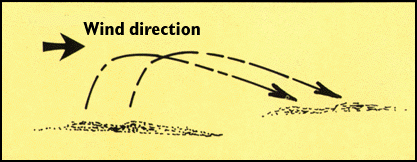
saltation
Sand sheets are flat, gently undulating sandy plots of sand surfaced by grains that may be too large for saltation. They form approximately 40 percent of eolian depositional surfaces. The Selima Sand Sheet, which occupies 60,000 square kilometers in southern Egypt and northern Sudan, is one of the Earth's largest sand sheets. The Selima is absolutely flat in some places; in others, active dunes move over its surface.
Wind blowing on a sand surface ripples the surface into crests and troughs whose long axes are perpendicular to the wind direction. The average length of jumps during saltation corresponds to the wavelength, or distance between adjacent crests, of the ripples. In ripples, the coarsest materials collect at the crests. This distinguishes small ripples from dunes, where the coarsest materials are generally in the troughs.
Sand Dunes and Sand Dune Dynamics
Sand dunes are hills or ridges of sand. They can be small or massive in size and begin when wind-blown sand collects behind an obstacle such as a row of bushes, some big rocks, a small rise or a wall or is simply channeled into a pile by wind currents. Additional sand collects around the edges, forming crescent shaped mounds of sand called barchan dunes.
Dunes are constantly on the move as sand on the windward side blows to the leeward side. Some dunes move as much as two feet a week. When dunes grow to mammoth size, they may slow to such a crawl they almost stop moving. Large amounts of vegetation on a dune can stop a dune completely.
Wind-blown sand moves up the gentle upwind side of the dune by saltation or creep. Sand accumulates at the brink, the top of the slipface. When the buildup of sand at the brink exceeds the angle of repose, a small avalanche of grains slides down the slipface. Grain by grain, the dune moves downwind.
Accumulations of sediment blown by the wind into a mound or ridge, dunes have gentle upwind slopes on the wind-facing side. The downwind portion of the dune, the lee slope, is commonly a steep avalanche slope referred to as a slipface. Dunes may have more than one slipface. The minimum height of a slipface is about 30 centimeters.
Sand grains move up the dune's gentle upwind slope by saltation and creep. When particles at the brink of the dune exceed the angle of repose, they spill over in a tiny landslide or avalanche that reforms the slipface. As the avalanching continues, the dune moves in the direction of the wind. [Sources: “Deserts: Geology and Resources” by A.S. Walker, United States Geological Survey]
Some of the most significant experimental measurements on eolian sand movement were performed by Ralph Bagnold, a British engineer who worked in Egypt prior to World War II. Bagnold investigated the physics of particles moving through the atmosphere and deposited by wind. He recognized two basic dune types, the crescentic dune, which he called "barchan," and the linear dune, which he called longitudinal or "sief" (Arabic for "sword").
Star Dunes, Parabolic Dunes and Other Types of Sand Dunes
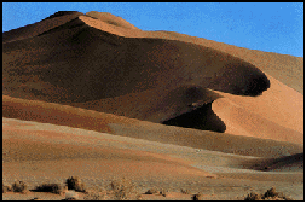
world's largest sand suns
in Namibia A worldwide inventory of deserts has been developed using images from the Landsat satellites and from space and aerial photography. It defines six basic types of dunes: crescentic, linear, star, dome and parabolic. [Sources: “Deserts: Geology and Resources” by A.S. Walker, United States Geological Survey]
Linear dunes are straight or slightly sinuous sand ridges typically much longer than they are wide. They may be more than 160 kilometers long. Linear dunes may occur as isolated ridges, but they generally form sets of parallel ridges separated by miles of sand, gravel, or rocky interdune corridors. Some linear dunes merge to form Y-shaped compound dunes. Many form in bidirectional wind regimes. The long axes of these dunes extend in the resultant direction of sand movement.
Star dunes are radially-symmetrical, spyramidal sand mounds with slipfaces on three or more arms that radiate from the high center of the mound. They are created when the winds blow equally from every direction, causing the sand dune to grow many extensions and resemble a star. They are rare and are fairly stable and remain in the same place. Some are landmarks with names.
Star dunes tend to accumulate in areas with multidirectional wind regimes. Star dunes grow upward rather than laterally. They dominate the Grand Erg Oriental of the Sahara. In other deserts, they occur around the margins of the sand seas, particularly near topographic barriers. In the southeast Badain Jaran Desert of China, the star dunes are up to 500 meters tall and may be the tallest dunes on Earth.
Dome dunes are rare and occur at the far upwind margins of sand seas. Oval or circular mounds that generally lack a slipface. Dome dune are created when a strong blow all the sands into one place. Solid dunes are created by the daily cycle of dampening from morning dew and drying, which leaches iron from sand granules.
Parabolic dunes are U-shaped mounds of sand with convex noses trailed by elongated arms. They tend to be large, stable and gently sloping. Also known as U-shaped, whaleback, blowout, or hairpin dunes, they are well known in coastal deserts. Unlike crescentic dunes, their crests point upwind. The elongated arms of parabolic dunes follow rather than lead because they have been fixed by vegetation, while the bulk of the sand in the dune migrates forward. The longest known parabolic dune has a trailing arm 12 kilometers long.
Crescent-Shaped Sand Dunes
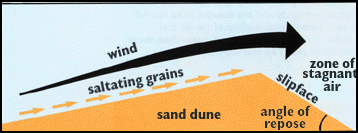
The most common dune form on Earth and on Mars is the crescentic. Crescent-shaped (also known ongitudinal dunes) mounds generally are wider than long. Caused by prevailing winds, they form ridges and cluster into dune fields and advance across the desert. The wind blows the sand up the gentle slope to the crest. Then with nothing hold it in place, the crest topples and slides down the steep front face and is replaced by sand coming up the gentle slope.
The slipface is on the dune's concave side. These dunes form under winds that blow from one direction, and they also are known as barchans, or transverse dunes. Barchans (pronounced bar-KAHNS) dunes have a crescent shape when viewed from above. Some types of crescentic dunes move faster over desert surfaces than any other type of dune. A group of dunes moved more than 100 meters per year between 1954 and 1959 in China's Ningxia Province; similar rates have been recorded in the Western Desert of Egypt. The largest crescentic dunes on Earth, with mean crest-to-crest widths of more than 3 kilometers, are in China's
Many shifting longitudinal dunes ride on top of whale back dunes. Snaking sand dunes are caused by winds blowing from a prevailing direction, but with frequent shifts as much as 45̊ right and left. Small crescentic dunes occur on the crests of these complex dome dunes of Saudi Arabia's Empty. Occurring wherever winds periodically reverse direction, reversing dunes are varieties of any of the above types. These dunes typically have major and minor slipfaces oriented in opposite directions.
Dune Shapes and Behavior
"A dune is a curiously dynamic creature," wrote Farouk El-Baz in National Geographic. “Once formed, a dune can grow. It can change shape and move with the wind. It can even breed new dunes. Some of these offspring may be carried on the back of the mother dune. Others are born and race downwind, outpacing their parents. [Source: Farouk El-Baz, National Geographic, February 1982]
All dune types may occur in three forms: simple, compound, and complex. Simple dunes are basic forms with a minimum number of slipfaces that define the geometric type. Compound dunes are large dunes on which smaller dunes of similar type and slipface orientation are superimposed, and complex dunes are combinations of two or more dune types. A crescentic dune with a star dune superimposed on its crest is the most common complex dune. Simple dunes represent a wind regime that has not changed in intensity or direction since the formation of the dune, while compound and complex dunes suggest that the intensity and direction of the wind has changed. [Sources: “Deserts: Geology and Resources” by A.S. Walker, United States Geological Survey]
The shape of dunes is affected by things like the strength, direction and consistency of the winds; the consistency and amount of sand; the hardness if the terrain and the amount of vegetation. The leeward sides of dunes can be quite steep: steep enough to cause a vehicle to flip over.
Dunes in coastal areas are often more active than those in deserts. The frequent passage of fronts and storms and the differences between land and sea temperatures cause more wind and more dune movement. In areas with sand dunes, the sand is often so hot and dry that plants or grass can not grow on it.
Large crescent-shaped dunes move more slowly that small ones. Some times when a small one collides with a big one it looks as if the small one passes through the big one but what actually happens is the larger one loses some its sand to the smaller one. Thus the former larger one, now the smaller ones, surges forward ahead.
Killer Dunes
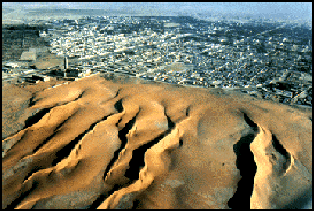
town killer dunes in Mauritania In some place killer dunes roll in and swallow up towns. Parts of the Kharga Oasis in Egypt are currently being swallowed up dunes. Entire villages have disappeared under the sand. In a few instances the government built new villages for those displaced only to find that new villages themselves were buried several years later. Aerial photographs of these marauding dunes are something to behold. In one portion of the photo is a lush green paradise. Engulfing the paradise is a massive line of dunes. [Source: Farouk El-Baz, National Geographic February 1982]
In some places, vegetation-covered dunes lose their vegetation due to careless fires and start moving and swallowing up places where people live.
Singing Sand Dunes
Sand dunes can “sing” at a level up to 115 decibels and generate sounds in different notes. The dunes at Sand Mountain n Nevada usually sing in a low C but can also sing in B and C sharp. The La Mar de Dunas in Chile hum in F while those at the Ghord Lahmar in Morocco howl in G sharp. [Source: New York Times]
The sounds are produced by avalanches of sand generated by blowing winds. For a while it was thought that the avalanches caused the entire dune to resonate like a flute or violin but if that were true then different size dunes would produce different notes.
In the mid 2000s, American, French and Moroccan scientists visiting sand dunes in Morocco, Chile, China and Oman published a paper in the Physical Review Letters that determined the sounds were produced by collisions between grains of sand that caused the motions of the grains to become synchronized, causing the outer layer of a dune to vibrate like the cone of a loudspeaker, producing sound. The tone of the sounds depended primarily on the size of the grains. The scientists said that the dunes in Oman produced a “very pure sound” and were “really singing” while those in China hardly sang at all.
Image Source: United States Geological Survey (USGS) usgs.gov/gip/deserts except caravan picture Silk Road Foundation
Text Sources: "Deserts Geology and Resources" by A.S. Walkers, USGS Online publication; Rick Gore, National Geographic, November 1979 [┵]; New York Times, Washington Post, Los Angeles Times, Daily Yomiuri, Times of London, National Geographic, The New Yorker, Time, Newsweek, Reuters, AP, Lonely Planet Guides, Compton’s Encyclopedia and various books and other publications.
Last updated March 2011
